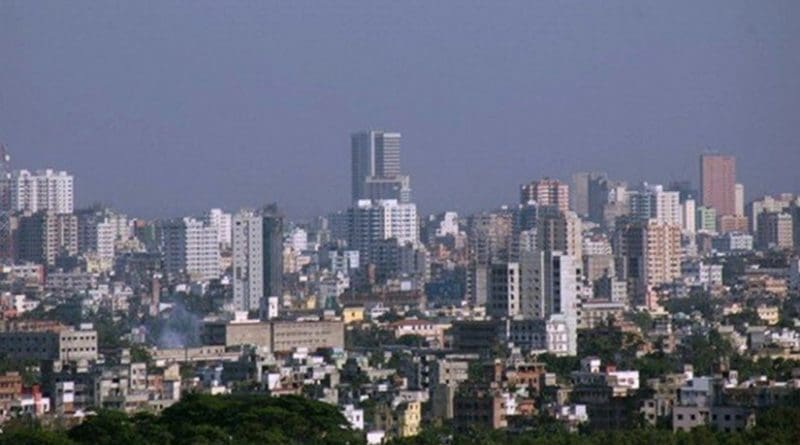Bangladesh Should Make Country Better Place For Disabled – OpEd
By Muhammad Ubaidul Haque*
Bangladesh is a role model of development in the developing world and transforming with fascinating changes in different areas of global indices.
Accessibility, inclusiveness and establishing the rights and dignity of persons with disabilities (PWDs) are being considered as important criteria of sustainable and inclusive development all over the world. It is a legal and rational demand of time and there are obligations locally and globally to establish the accessibility rights of persons with disabilities (PWDs).
Accessibility focuses on enabling access for PWDs and strongly related to universal design which is the process of creating products, devices, services, infrastructure, roads, transport and environment that are usable by people with the widest possible range of abilities, operating within the widest possible range of situations. This is about making things accessible to all people (whether they have a disability or not).
The following legislative obligations have been made in Bangladesh to ensure accessibility for persons with disabilities:
The Constitution of the People’s Republic of Bangladesh assures and conveys it in article 15(d) where it says: “The right to social security, that is to say, to public assistance in cases of undeserved want arising from unemployment, illness or disablement, or suffered by widows or orphans or in old age, or in other such cases.”
The “Rights and Protection of Persons with Disabilities Act 2013” was passed with a view to ensuring the 21 rights and dignity of persons with disabilities. The aim of the Act is to guarantee the educational, physical and mental improvement of persons with disabilities and to support their participation in social and state activities by removing all sorts of discrimination and ensuring accessibility in building, roads, transport, educational institutions, hospitals, courts, police stations, rail stations, bus terminals, airports and other ports, shelters, cyclone shelters, cultural centres, tourist spots, service centres, parks, libraries, historical places, public spaces, public toilets, underpasses and over-bridges.
The “Dhaka Mahanagar Building (Construction, Development, Protection and Removal) Rule 2008” in article 64 assures about accessibility for students with disabilities in buildings and infrastructure, including 5 per cent toilets which will be PWD-accessible.
The United Nations “Convention on the Rights of the Persons with Disabilities (CRPD)” articulated in article 9 on accessibility. Bangladesh has signed and committed to following the principles enunciated therein.
The “Sustainable Development Goals (SDG)” with its 17 goals and 169 targets included the issue of persons with disabilities in Goals 4 and 11 and in targets 11.2 and 11.7 where emphasis is given on accessibility for PWDs through special provision.
There are some practices at present but not adequate implementation. The government initiated the draft of “Bangladesh Road Transport Act 2016” having some inconsistencies and misconception on defining ‘invalid carriage’ instead of disabled-friendly or accessible carriage. This has been already pointed out in different seminars and meetings of Women with Disabilities Development Foundation and Physically-challenged Development Foundation and by others.
Accessibility is more or less ensured at Shaheed Minar, National Memorial, Mahasthangarh and Sonargaon, though it is inadequate at Komlapur Railway and Dhaka Cantonment Railway stations.
Among educational institutions, Dhaka University has ensured accessibility but inadequately in 5-6 building although there are more than 100 buildings in the university. The remaining universities in the country are not attentive on the issue of accessibility.
The Prime Minister’s Office is working to ensure accessibility through different websites having a national consultant who is a visually-impaired official.
There are disability related focal persons in the Ministry of Social Welfare and in other ministries. The government of Bangladesh has also allocated 100 crore taka towards facilitating accessibility during the 2016-2017 Financial Year which indicates the progressive attitude of the government.
The implementation of the rights of PWDs assured by the provision in the constitution of Bangladesh, “Rights and Protection of Persons with Disabilities Act 2013” and “Dhaka Mahanagar Building (Construction, Development, Protection and Removal) Rule 2008” are not being followed strictly.
Developer organisations are not conscious and don’t care about providing accessibility facilities for the PWDs and even the government is breaking the rules in building construction. Conventions on the Rights of the Persons with Disabilities (CRPD) and SDGs have given emphasis on inclusiveness and accessibility.
Bangladesh has showed fascinating success in achieving the Millennium Development Goals (MDGs). In the era of SDGs, too, Bangladesh should give stress on implementation of the targeted goals and global conventions. Otherwise, it would cause hampering of the success in SDGs for Bangladesh.
The government should be prepared to take the responsibility with more knowledge and skill in a conscious manner along with making the people’s representatives, law-makers, architects and planning authorities aware of this issue.
Overall, the government, civil society, NGOs, disability rights organisations, mass media, academicians and intellectuals have to work together to make Bangladesh accessible, inclusive and a better place for persons with disabilities (PWDs).
*The author is Master of Social Sciences (MSS) student in the Department of Public Administration at University of Dhaka. He is also Manager, Youth Network at Physically-challenged Development Foundation (PDF), Dhaka, Bangladesh. Comments and suggestions on this article can be sent to [email protected]

